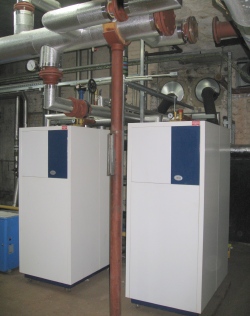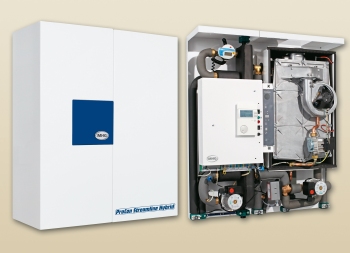Maximising system efficiency

With gas and oil boilers still being the dominant heating plant in most projects, it is essential that heating systems fully exploit their inherent efficiency argues Graham Rodd of MHG Heating.
While considerable attention is paid to renewable and low-carbon heat sources such as solar thermal and heat pumps, it is a fact that most heating installations include a gas or oil fired boiler. Certainly, it is now more common for those boilers to be combined with other heat sources, but it is still essential that the design takes full advantage of the energy-saving opportunities offered by modern boilers.
The key to achieving this is to ensure that the control strategy is as efficient as the inherent efficiency of the boiler. For example, weather compensation helps to extend the times when return-water temperatures are sufficiently low for good condensing. It therefore makes sense to specify a boiler that includes weather compensation as standard, rather than this being an added extra that might get ‘value-engineered’ out.
It is equally important to take account of general improvements in the thermal performance of buildings. In particular, spaces in more thermally efficient buildings tend to reach set-point temperature more quickly and require less heat energy to maintain comfort conditions.
This means that the heating plant needs to be able to cope with considerably more variation in heat loads than used to be the case. This is one of the reasons for the growing use of cascade boiler systems, typically comprising a number of modular boilers, each of which has a modulating capabilities.
 |
| These replacement boilers at London’s Victoria Station have integral plate heat exchanger to separate them from the old heating system. |
Again, it is essential that these are controlled effectively, using the ability to turn individual boilers off and also utilise the turndown of the burner to vary heat output. At the same time, it is important to maintain the designed temperature differential between flow and return water. Not maintaining this differential can result in excessive cycling, which wastes energy. The controls really need to ‘talk the boilers’ language’.
Cascade boiler systems can also make a significant contribution to reducing overall project costs because they lend themselves to off-site pre-fabrication. To that end, supplying cascade boiler systems with matched frames, hydraulic kits, flues and controls kits should be a standard procedure.
They also take up less plant room space, which can make it easier to include other heat sources in the mix whilst keeping all the heating plant in one location.
A major challenge facing the UK’s ambitions to reduce carbon emissions is the relatively inefficient performance of much of our existing building stock. Retrofit boilers clearly have a significant role to play in helping to improve the overall efficiency of these buildings.
However, one recurring issue with retrofit boiler projects is the condition of the existing heat-distribution system. In particular, there is potential for contaminated system water in the pipework to damage the boiler.
In our experience of many such retrofit projects we have found the most effective solution is including internal plate heat exchangers in the boilers. These act as boiler separation plates and keep the two systems separate while taking advantage of the higher efficiency of the new boiler. This is a development that has proved very useful in a wide range of different applications.
Retrofit projects can also benefit from the use of weatherproofed boilers for exterior siting in projects where plant room space is limited.
As mentioned above, it is increasingly common to mix different heating technologies in order to take advantage of low-carbon heat sources. Consequently, we are seeing growing interest in packaged condensing boilers and air-source heat pumps (ASHP) as hybrid packages, as well as combined air-source and ground-source heat pump (GSHP) hybrids.
 |
| Combining an air-to-water heat pump and gas-fired condensing boiler is this hybrid unit. |
When specifying these hybrids there should, once again, be considerable emphasis on how they are controlled. For example, when a condensing boiler and ASHP are used together it is common practice to switch off the ASHP at, say, an ambient temperature/bivalence point of 5°C, leaving the boiler to meet all heating loads. However, with a good control strategy the ASHP can be configured to work with a variable bivalence point, maintaining an acceptable coefficient of performance (COP) while enabling the ASHP to meet part of the load.
In the case of ASHP/GSHP hybrids a major advantage is that a variable bivalence point enables the GSHP to be used less. This means it extracts less heat from the ground so less time is required for the ground to recuperate, and, in turn, less-extensive groundworks are required. The result is a considerable cost saving that can make all the difference to the financial viability of using GSHPs.
The recurring message through all of these points is that effective control is vital if efficient heat sources are to realise their full potential and the end client is to gain the best value.
Graham Rodd is managing director of MHG Heating







